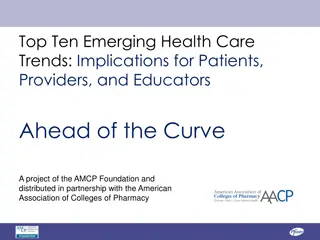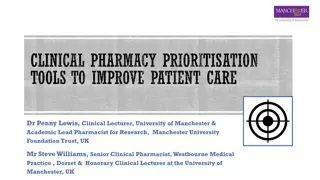Trends and Insights in the Pharmacy and Drug Store Industry
Retail sales data for pharmacies and drug stores show steady growth in revenues for 2017 and 2018. Major players like Kroger, Walgreens, and CVS have made strategic acquisitions to expand their market share. Beauty product purchases are influenced by trends, with a shift towards natural ingredients driving over-the-counter sales. Customer satisfaction in brick-and-mortar and mail-order pharmacies remains high, with added services like health clinics enhancing consumer experience.
Download Presentation

Please find below an Image/Link to download the presentation.
The content on the website is provided AS IS for your information and personal use only. It may not be sold, licensed, or shared on other websites without obtaining consent from the author. Download presentation by click this link. If you encounter any issues during the download, it is possible that the publisher has removed the file from their server.
E N D
Presentation Transcript
Revenues in the Pink US Census Bureau retail sales data for pharmacies and drug stores (NAICS 44611) reveals a 2.2% increase (adjusted) for 2017, or a total of $277.26 billion, compared to $271.39 billion for 2016. During the first 9 months of 2018, the trend was even healthier, as retail sales increased 3.8% (adjusted), or $214.36 billion, compared to $206.49 billion for the first 9 months of 2017. According to Chain Store Guide, Kroger was the #1 supermarket chain in prescription sales, or $10.43 billion, during the first half of 2018; followed by Albertsons, $4.90 billion; Safeway, $2.70 billion; Publix, $2.25 billion; and H-E-B, $1.58 billion.
Reducing the Competition Through Acquisitions Instead of merging with Rite Aid during 2018, Walgreens Boots Alliance (WBA) acquired 1,932 of its stores, which positively influenced WBA s Q1 2019 fiscal-year revenues, increasing 9.9%, or $33.8 billion, with retail pharmacy sales increasing 14.4%. CVS Health s $70-billion acquisition of health insurer Aetna during November 2018 has created a new behemoth in the healthcare industry. Aetna will continue to operate as a separate unit, but new services and products will be available to all consumers. Other new agreements include Walgreens partnership with FedEx to deliver prescription orders the next day nationwide and same-day in some cities while Kroger is partnering with GoodRx to start Rx Savings Club to provide patients with additional savings.
Trends Heavily Influence Beauty Products Purchases According to an August 2018 issue of Drug Store News Daily, beauty trends continue to influence beauty product sales as, for example, the convenience of a shampoo/conditioner combo pack increased sales 20% for the 52 weeks ending 6/17/18. Conversely, the popularity of facial hair (among men) resulted in a 1.0% unit-sales decrease for the top 10 razor brands, a 5.5% decrease for the top 10 razor cartridges and a 4.3% decrease for the top 10 disposable razors. Similar trends, such as the use of less eye shadow, caused a 10% decrease in dollar sales and 13.5% decrease in unit sales, while the popularity of eye brow makeup boosted dollars sales 19.1% and unit sales 14.2%.
Natural Ingredients Drive OTC Sales OTC products with natural ingredients is a major consumer trend in this category, according to the August 25th, 2018 issue of Drug Store News Daily. For example, two sleeping aid tablets with melatonin from VMS (vitamins, minerals and supplements) manufacturers had huge dollar sales changes: Olly, +85.4%, and Vitafusion, +31.9%. A preference for private-label brands is another continuing trend among OTC products consumers, especially vitamins, as private-label had the only double- digit share, or 16.9%, in the multivitamin category.
Consumers Very Satisfied with Their Pharmacies of Choice According to the J.D. Power 2018 U.S. Pharmacy StudySM, consumers give brick-and-mortar pharmacies and mail-order pharmacies some of the largest average scores 847 and 859, respectively, of any industries J.D. Power measures. Pharmacies addition of retail health clinics has been the primary influence of positive customer satisfaction. Pharmacies with these services receive satisfaction scores 66 points higher than pharmacies without them. Prescriptions delivered on time is the major factor for mail-order pharmacy satisfaction, resulting in a satisfaction score of an additional 78 points.
Amazons Next Disruption Move Amazon has hinted for some time it might enter the prescription-drugs market and its $1-billion acquisition of PillPack during June 2018 indicates an increasing level of serious consideration to challenge the big pharmacy chains, such as CVS and Walgreens. Brick-and-mortar pharmacies rely heavily on prescription drugs sales, as they represent 72.5% of all US pharmacy sales. An Amazon foray into the industry could significantly affect the brick-and-mortar chains and other online retailers. Another potential advantage for Amazon is its joint venture with Berkshire Hathaway Inc. and JP Morgan Chase & Co. to bypass pharmacy benefit managers (middlemen) and decrease the costs for all three companies employees.
Advertising Strategies With the increasing number of seniors enrolled in Medicare part D, local and regional pharmacies can use TV, specifically, in conjunction with direct mail, to brand themselves as a pharmacy dedicated to helping seniors make better health decisions. Pharmacies with a large percentage of seniors as regular customers may want to test a delivery service to a limited geographic area. Once it proves popular and beneficial to test customers, then expand the service and use advertising to brand it. As major pharmacies add and promote in-store retail health clinics, local and regional pharmacies must do the same, offering personalized services. If possible, assign a current staff member or hire a dedicated one for this role, and promote the service aggressively.
New Media Strategies To remain competitive, local and regional pharmacies with smaller staffs may find it beneficial to add a chatbot app via their Websites to make it easier and more convenient to answer customers questions who can t take the time to call or visit the pharmacy. Although adding a specialty drug service may be expensive, pharmacies can first use email campaigns and/or social media to survey their customers to determine what percentage have been prescribed specialty medications to determine the local need. As more and more consumers search for healthcare information on various Websites, such as WebMD and Mayo Clinic, pharmacies can post a daily or weekly link on social media to share the latest articles/information from these sources about prescription drugs.























